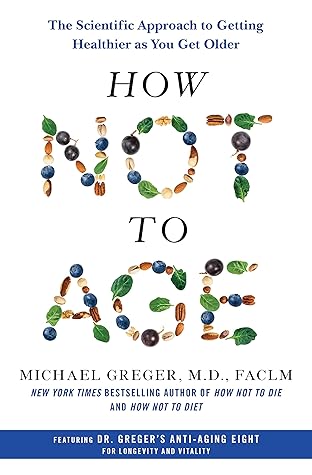More on this book
Community
Kindle Notes & Highlights
Markers of late-life health, including improved blood pressure, cholesterol, mitochondrial function, insulin sensitivity,7866 and immune function were also best on the low-protein diets and worst on the high-protein or high-fat diets.
The restriction of protein, not calories, was found to be driving the survival effect.7871 In fact, researchers discovered that only restricting calories appeared to shorten lifespans.
Just as many of the benefits of dietary restriction can be replicated simply by restricting protein,7922 most of the benefits of protein restriction may be due to the reduction of just a few of the amino acids that make up proteins, for example, methionine.
The exact mechanisms by which reducing dietary methionine leads to slower aging are not known,7932 but methionine restriction boosts FGF21,7933 induces autophagy,7934 and reduces inflammation7935 and IGF-1.7936
reducing methionine intake profoundly reduces mitochondrial free radical generation and oxidative damage to mitochondrial DNA,7942 consistent with the mitochondrial theory of aging (see here), the only amino acid ever shown to do so. Even restricting every other amino acid except for methionine fails to reproduce this effect.
Of all the amino acids, methionine is also one of the most vulnerable to oxidation.
methionine restriction could be accomplished by switching from animal to plant protein sources, which tend to be relatively low in methionine.
A review on methionine restriction for life extension concluded, “In humans, methionine restriction may be achieved using a predominately vegan diet.
On average, vegans consume 47 percent less methionine than meat eaters.7973 Perhaps this helps explain some of the health benefits attributed to plant-based diets.
On average, American women effectively consume twice as much methionine as they need and American men three times as much.7980 Given the cardiometabolic risk associated with higher intake, public health researchers suggest that the optimum intake may be down around the recommended intake.7981 So, just as I’m not advocating for a low-protein diet but rather a diet with the recommended amount, one need not eat a low-methionine diet but rather just one without excess methionine. Given what we now know, simply decreasing intake to recommended levels “has a great potential to lower tissue oxidative
...more
Note that protein restriction is the only intervention in the chart here that blocks every one of the eleven aging pathways,
The best available balance of evidence supports the advice of longevity experts like Drs. Valter Longo8066 and Luigi Fontana to advise cutting down on protein to live longer: “Eating more protein than what is needed … will not increase muscle mass but will accelerate aging and increase the risk of developing many chronic diseases.
nicotinamide adenine dinucleotide (NAD
NAD+ is now known as an essential molecule for all living organisms,8070 required for the function of about five hundred enzymatic reactions,8071 including, notably, the extraction of metabolic energy from food.8072 The twenty-first century has produced yet another scientific renaissance for NAD+ with the realization that it was critical for the activity of sirtuins,8073 those “guardians of mammalian healthspan”
NAD+ is one of the most abundant molecules in our body. Once considered relatively stable, it is now known to be in a constant state of synthesis, recycling, and breakdown.8075 Our pool of NAD+ is turned over as often as several times a day.
The pitch for NAD+ boosting as an anti-aging strategy is as follows: All species, including humans, naturally experience a decline in NAD+ levels over time, and this decline is in fact one of the major reasons organisms age.
The bottom line is that, given the conflicting findings from the remarkably few studies on the subject, it is misleading to say NAD+ universally decreases with age.8092 Regardless, the proof is in the pudding. What about the second premise, that boosting levels late in life can improve health and longevity?
Our body can also make NAD+ from scratch from the amino acid tryptophan. Given the critical nature of NAD+, it is perhaps unsurprising that the body has so many different pathways utilizing a panoply of precursors.


